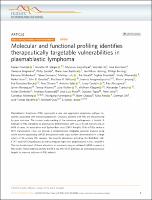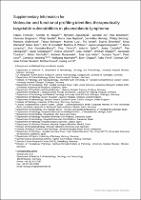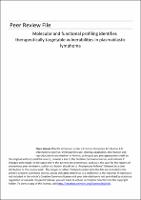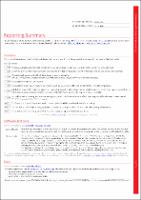| dc.contributor | Vall d'Hebron Barcelona Hospital Campus |
| dc.contributor.author | Frontzek, Fabian |
| dc.contributor.author | Staiger, Annette M. |
| dc.contributor.author | Zapukhlyak, Myroslav |
| dc.contributor.author | Xu, Wendan |
| dc.contributor.author | Bonzheim, Irina |
| dc.contributor.author | Borgmann, Vanessa |
| dc.contributor.author | Castellví Vives, Josep |
| dc.contributor.author | Abrisqueta Costa, Pablo |
| dc.date.accessioned | 2022-04-25T10:18:34Z |
| dc.date.available | 2022-04-25T10:18:34Z |
| dc.date.issued | 2021-08-31 |
| dc.identifier.citation | Frontzek F, Staiger AM, Zapukhlyak M, Xu W, Bonzheim I, Borgmann V, et al. Molecular and functional profiling identifies therapeutically targetable vulnerabilities in plasmablastic lymphoma. Nat Commun. 2021 Aug 31;12:5183. |
| dc.identifier.issn | 2041-1723 |
| dc.identifier.uri | https://hdl.handle.net/11351/7391 |
| dc.description | B-cell lymphoma; Cancer genetics |
| dc.description.abstract | Plasmablastic lymphoma (PBL) represents a rare and aggressive lymphoma subtype frequently associated with immunosuppression. Clinically, patients with PBL are characterized by poor outcome. The current understanding of the molecular pathogenesis is limited. A hallmark of PBL represents its plasmacytic differentiation with loss of B-cell markers and, in 60% of cases, its association with Epstein-Barr virus (EBV). Roughly 50% of PBLs harbor a MYC translocation. Here, we provide a comprehensive integrated genomic analysis using whole exome sequencing (WES) and genome-wide copy number determination in a large cohort of 96 primary PBL samples. We identify alterations activating the RAS-RAF, JAK-STAT, and NOTCH pathways as well as frequent high-level amplifications in MCL1 and IRF4. The functional impact of these alterations is assessed using an unbiased shRNA screen in a PBL model. These analyses identify the IRF4 and JAK-STAT pathways as promising molecular targets to improve outcome of PBL patients. |
| dc.language.iso | eng |
| dc.publisher | Nature Research |
| dc.relation.ispartofseries | Nature Communications;12 |
| dc.rights | Attribution 4.0 International |
| dc.rights.uri | http://creativecommons.org/licenses/by/4.0/ |
| dc.source | Scientia |
| dc.subject | Cèl·lules B - Tumors - Tractament |
| dc.subject | Seqüència de nucleòtids |
| dc.subject | Sistema limfàtic - Càncer - Mortalitat |
| dc.subject.mesh | Plasmablastic Lymphoma |
| dc.subject.mesh | /therapy |
| dc.subject.mesh | Whole Exome Sequencing |
| dc.title | Molecular and functional profiling identifies therapeutically targetable vulnerabilities in plasmablastic lymphoma |
| dc.type | info:eu-repo/semantics/article |
| dc.identifier.doi | 10.1038/s41467-021-25405-w |
| dc.subject.decs | linfoma plasmablástico |
| dc.subject.decs | /terapia |
| dc.subject.decs | secuenciación del exoma completo |
| dc.relation.publishversion | https://doi.org/10.1038/s41467-021-25405-w |
| dc.type.version | info:eu-repo/semantics/publishedVersion |
| dc.audience | Professionals |
| dc.contributor.organismes | Institut Català de la Salut |
| dc.contributor.authoraffiliation | [Frontzek F, Zapukhlyak M, Xu W] Department of Medicine A, Department of Hematology, Oncology and Pneumology, University Hospital Münster, Münster, Germany. [Staiger AM] Dr. Margarete Fischer-Bosch Institute of Clinical Pharmacology, Stuttgart and University of Tuebingen, Tübingen, Germany. Department of Clinical Pathology, Robert Bosch Hospital, Stuttgart, Germany. [Bonzheim I, Borgmann V] Institute of Pathology and Neuropathology, Eberhard Karls University of TübingenComprehensive Cancer Center, University Hospital Tübingen, Tübingen, Germany. [Castellvi J] Servei de Patologia, Vall d’Hebron Hospital Universitari, Barcelona, Spain. [Abrisqueta P] Servei d’Hematologia, Vall d’Hebron Hospital Universitari, Barcelona, Spain |
| dc.identifier.pmid | 34465776 |
| dc.identifier.wos | 000692406300007 |
| dc.rights.accessrights | info:eu-repo/semantics/openAccess |




